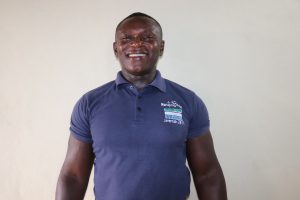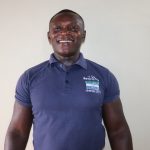September, 2022: Royeamp Community New Borehole Well Project Complete!
We are excited to share that there is now a safe, reliable borehole well at Royeamp Community. As a result, community members no longer rely on unsafe water to meet their daily needs. We also conducted hygiene and sanitation training, which focused on healthy practices such as handwashing and using latrines.
"I am glad for the provision of safe and pure drinking water that you have done in our village," said 12-year-old Kadiatu K. "We have been suffering for some time now for water. The distance from my house to the stream is too far. I hardly do many trips for the day because of the walking distance. There are times the water from the stream becomes dirty. This made it impossible for me to fetch water for cooking and drinking. Now that we have this new water point, I am so excited because all the water constraints I used to face would now become history."

Kadiatu at the well.
"I [will] have enough water to do all my work at home before going to school," Kadiatu continued. "I was suffering a lot to fetch water for domestic activities such as cooking, bathing, and drinking. But today, I am happy for the water point that [you all] have provided for us."
"All my lifetime, I relied on the swamp water as my main source of fetching water," said 33-year-old farmer Isatu Kamara. "The distance to the swamp was unbearable for me. This had prevented me from having enough water at home. This has affected me greatly around cooking, bathing, and laundering. That is why I am very happy [now that] the community finally has a new waterpoint. This will prevent all the unnecessary water constraints I used to experience."

Isatu drinks the well's water while community members celebrate.
"Today is one of my happy days for having safe and pure drinking water in this community," Isatu continued. "I want to give thanks to the almighty God for giving us the opportunity to drink safe and pure water. I believe that this water [will] help us to reduce the waterborne diseases that are affecting us in the community, and we will practice frequent handwashing to avoid bacteria transmission."

Isatu and Kadiatu celebrate at the well.
We held a dedication ceremony to officially hand over the well to the community members. A representative from Port Loko District Council also attended, which made the event more special.

Councilor Bangura pours water at the well.
District Councilor Abubakarr Bangura and the village headman gave short speeches thanking everyone who contributed to this water project and reminding everyone to take good care of it.
“I am so happy to get safe and pure drinking water today," said village headman Abu Kamara. "[For] over 40 years, we have been struggling for pure drinking water. But we now have safe and pure drinking water that is very much sustainable. On behalf of the Royeamp community people, I want to extend my gratitude for averting the water crisis in this community."
Then, Kadiatu and Isatu made statements on their community's behalf. The ceremony concluded with celebration, singing, and dancing.

New Well
The drill team arrived the day before beginning work. They set up camp and unpacked all their tools and supplies to prepare for drilling the next day. The community provided space for the team to store their belongings and meals for the duration of their stay. The following day, work began.
Our team dug two pits next to the drill rig, one for the drill’s water supply and another for what the drill pulls out of the borehole. In some cases, we order a private supplier to deliver the water for drilling since water access is already challenging.

Day one of drilling began as the team mixed water with bentonite, an absorbent clay, in the two dug pits. Next, the team fixed a four-inch carbide-tipped bit to the five-foot-long drill stem. They started the mud pump to supply water to the drill rig so that drilling could begin!
After putting each five-foot length of drill stem into the hole, the team took material samples. We labeled the bags to review them later and determine the aquifer locations.
On the second day of drilling, the team expanded the hole and cleared it of mud. After reaching a total depth of 23 meters, the team forcefully pumped clean water into the well to remove any dirt and debris from the drilling process. We then protected the screened pipe by adding a filter pack. The team hoisted the temporary drilling casing to fortify the pipes with cement.

Next, we bailed the well by hand for three days before conducting a yield test to verify the water quantity. This well has a static water level of 17 meters. With these excellent results, we installed a stainless steel pump. Water quality test results showed that this was clean water fit for drinking!

New Knowledge
Before conducting any hygiene training, we called and visited the local water user committee to understand the community’s challenges and lack of sanitation facilities. We shared the findings from our discussions with the committee members to help them make the necessary adjustments before the training began. For example, we identified households without handwashing stations or ones that may need to repair their latrines. With this information, community members worked together to improve hygiene and sanitation at home.
After this preparatory period, we scheduled a time when members from each household using the water point could attend a three-day hygiene and sanitation training. We then dispatched our teams to the agreed-upon location to hold the meeting.

Training topics covered included handwashing and tippy taps, good and bad hygiene habits, disease transmission and prevention, COVID-19, worms and parasites, proper dental hygiene, proper care of the well's pump, keeping the water clean, the cost recovery system, the importance of using dish racks and clotheslines, the importance of toilets, keeping latrines clean, balanced diets, the diarrhea doll, and HIV and AIDS.

One of the training participants demonstrates handwashing with a tippy-tap.
We had asked Royeamp's people to send one representative from each household to attend the three days of training. They granted our request and more - on each day of training, more and more people showed up, which demonstrates Royeamp's commitment to change.
One of the most-discussed topic was nutrition, which we demonstrate using a three-legged stool, with each leg representing a major food group. When any of the legs is removed, the stool falls. Several community members said that certain foods are forbidden in their households because of their traditional cultural beliefs. One woman said that no one in her family is allowed to eat meat, fish, or eggs because it is thought that those foods will lead a person to witchcraft.

A participant shows others the three-legged stool.
Another participant named Ramatu Kamara shared a personal story to combat this way of thinking. She said that her first pregnancy was very difficult and her baby was born malnourished, so the nurses at the health clinic where she gave birth told Ramatu to eat plenty of protein for her next pregnancy to prevent this occurrence. Ramatu reported that the nurses were right - when she ate meat, fish, and eggs during her second pregnancy, she felt better, and her baby was born healthier. The other participants applauded Ramatu for her story.

"This training was valuable to me, and it also gives me more new knowledge that will also create more impact [in] my life concerning health and sanitation activities," said Ramatu, when we asked her about her opinions on the training. "I was doing things which [had] a lot of repercussions for my health and the health and safety of my children. I say a big thank you for impacting my knowledge. Based on this knowledge, I would now be able to take care of myself and the environment by cleaning, making sure my drinking container is always clean and covered, and ensuring that I cover my food to prevent food contamination."
Conclusion
This project required a substantial collaboration between our staff, our in-country teams, and the community members themselves. When an issue arises concerning the well, community members are equipped with the necessary skills to rectify the problem and ensure the water point works appropriately. However, if the issue is beyond their capabilities, they can contact their local field officers to assist them.
Also, we will continue to offer them unmatchable support as a part of our monitoring and maintenance program. We walk with each community, problem-solving together when they face challenges with functionality, seasonality, or water quality. Together, all these components help us strive for enduring access to reliable, clean, and safe water for this community.
With your contribution, one more piece has been added to a large puzzle of water projects. In our target areas, we’re working toward complete coverage of reliable, maintained water sources within a 30-minute round trip for each community, household, school, and health center. With this in mind, search through our upcoming projects to see which community you can help next!
Thank you for making all of this possible!




 Borehole Well and Hand Pump
Borehole Well and Hand Pump
 Rehabilitation Project
Rehabilitation Project

































